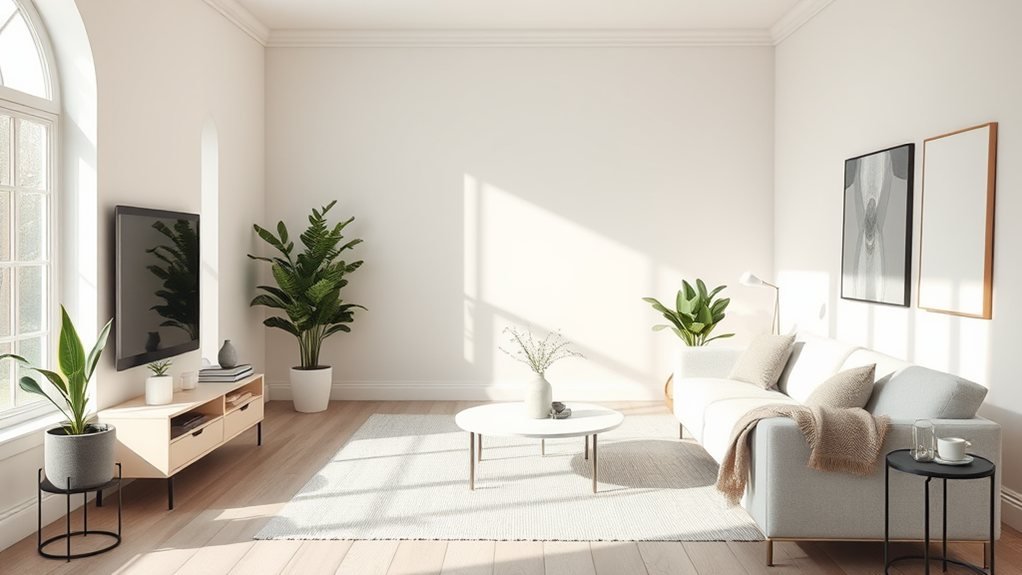10 Minimalist House Interior Decor Ideas for a Serene Space
Research shows that a well-organized, minimalist home can reduce stress levels by as much as 30%. If you’re looking to create a serene environment in your living space, embracing minimalism might be your best bet. It’s about more than just aesthetics; it’s a lifestyle choice that promotes peace and functionality. So, what are the key elements you can incorporate to transform your home into a calming retreat? Let’s investigate ten minimalist interior decor ideas that could redefine your space and mindset.
Embrace Decluttering Techniques

When you adopt decluttering techniques, you’ll find that transforming your space becomes much easier.
Start by setting specific goals. Identify areas in your home that feel cluttered. Break these down into smaller tasks, like focusing on a single room or drawer at a time.
Next, use the “one in, one out” rule: when you bring something new in, let something go. Sort your items into categories—keep, donate, or discard. Make quick decisions to avoid overthinking.
Finally, invest in storage solutions, like baskets or shelves, to keep remaining items organized. Regularly revisit these steps, and you’ll maintain a serene, minimalist environment.
With consistent effort, decluttering becomes a habit, allowing your space to feel more open and inviting.
Choose a Neutral Color Palette

Choosing a neutral color palette is essential for achieving a minimalist aesthetic. Neutral colors like whites, grays, and beige create a calm, inviting space. They make your rooms feel larger and more open, allowing natural light to shine through.
You can pair these shades with subtle textures to keep things interesting. For instance, think about using a soft gray sofa with a fluffy white throw blanket.
When selecting your colors, consider how they work together. Stick to two or three main tones to maintain harmony.
Remember, a neutral palette can be warmed up with natural materials, like wood or jute. These elements add depth without overwhelming your space.
Ultimately, choosing neutrals sets a serene foundation for your minimalist home.
Invest in Functional Furniture

Functional furniture is essential for creating a minimalist space that doesn’t sacrifice comfort or utility. When choosing your pieces, focus on multi-purpose items. For example, a sofa bed can serve as both seating and an extra sleeping area.
Look for coffee tables with storage underneath, allowing you to keep the space tidy. Invest in lightweight chairs that you can easily move around when needed.
Consider foldable tables for dining, which can be stored away when not in use. Prioritize quality over quantity; select a few well-crafted pieces instead of cluttering your space with many lesser items.
This approach improves both functionality and aesthetic appeal, making your minimalist home more comfortable and inviting.
Incorporate Natural Light

Natural light transforms a minimalist home, making it feel more open and inviting. To harness this effect, consider using large windows or glass doors. These features allow sunlight to flood your space.
If privacy is a concern, choose sheer curtains; they soften the light without blocking it completely. You can also position mirrors strategically to reflect sunlight, enhancing brightness and depth.
Opt for light-colored walls and furnishings; they’ll amplify the natural light. Avoid heavy drapes or dark colors, as they absorb light and can make a space feel cramped.
In addition, keep furniture arrangements open and uncluttered to allow light to flow freely. A little planning can help you create a serene, well-lit environment that accommodates your minimalist aesthetic.
Utilize Textured Fabrics

Adding textured fabrics to your minimalist decor introduces warmth and depth to your space. Consider using materials like linen, wool, or cotton. These fabrics can soften the sharp lines often seen in minimalist design.
Incorporate them through throw pillows, blankets, or area rugs, which can create inviting layers in your rooms.
Choose a neutral color palette to maintain that minimalist vibe, but don’t shy away from varying textures. A chunky knit throw or a velvet cushion can add visual interest without overwhelming the aesthetic.
When selecting pieces, aim for quality over quantity; one or two textured items can be more impactful than numerous decorations. Embracing these fabrics will improve your serene atmosphere while keeping it stylish and functional.
Limit Decorative Accents

When you pare down decorative accents, your minimalist space starts to breathe. Focus on the essentials that truly reflect your style.
Start by selecting a few key items, like a single vase or artwork, and let those speak for themselves. Avoid clutter by keeping surfaces clear; this creates a sense of openness.
Choose high-quality pieces that resonate with you rather than filling spaces with numerous small items. Color also matters; opt for neutral tones to maintain a calm atmosphere.
Use natural materials for added texture without overwhelming the space. Remember, less is more.
Limiting decorative accents helps draw attention to what you genuinely love while promoting tranquility in your environment.
Create Open Spaces

Creating open spaces is essential to achieving a minimalist aesthetic. To start, focus on decluttering your space. Remove unnecessary furniture and items that crowd your rooms. You want areas to feel fluid and breathable, not cramped.
Next, consider furniture arrangement. Position larger pieces away from walls to create pathways, allowing for easy movement throughout the space.
Incorporate fewer, larger pieces that make a statement instead of many small items. Use glass or light-colored furniture to improve the feeling of openness and light.
Additionally, keep window treatments simple. Sheer curtains can let in natural light without heavy drapery closing off the room.
Finally, choose light color palettes for your walls and floors to further amplify the airy ambiance.
Opt for Multi-Functional Items

To maximize space and maintain a minimalist vibe, opting for multi-functional items is key. These pieces serve several purposes, saving you both room and money.
For example, a sofa bed provides seating during the day and converts into a bed at night. Look for coffee tables with storage, which can hold books or blankets.
Dining tables that expand or fold can adapt to your needs, whether you’re hosting a small dinner or a larger gathering. Also, consider ottomans that double as storage units.
Focus on Quality Over Quantity

Choosing multi-functional items can lead you to another important concept in minimalist decor: focusing on quality over quantity.
When you prioritize quality, you’re selecting items that not only look good but also serve a purpose and last longer. Instead of filling your space with many low-quality items, invest in fewer, higher-quality pieces that truly improve your home.
Look for furniture made from durable materials and decor that resonates with you. Each item should have a distinct function and aesthetic appeal.
This strategy promotes a more serene environment, reducing clutter and improving overall harmony. Remember, each piece should contribute to the space’s beauty and functionality, creating a peaceful retreat where you can relax and recharge.
Integrate Greenery Mindfully

While adding greenery can improve your minimalist decor, it’s essential to do so mindfully to maintain a clean and uncluttered aesthetic.
Choose plants that require low maintenance, like succulents or snake plants. These options don’t just look great; they also purify the air.
Opt for a few strategic placements rather than cluttering your space. For instance, place a single large plant in a corner or a trio of small pots on a windowsill.
Use simple, elegant planters that match your decor. Consider hanging plants as well, which can save floor space while bringing life to the walls.

